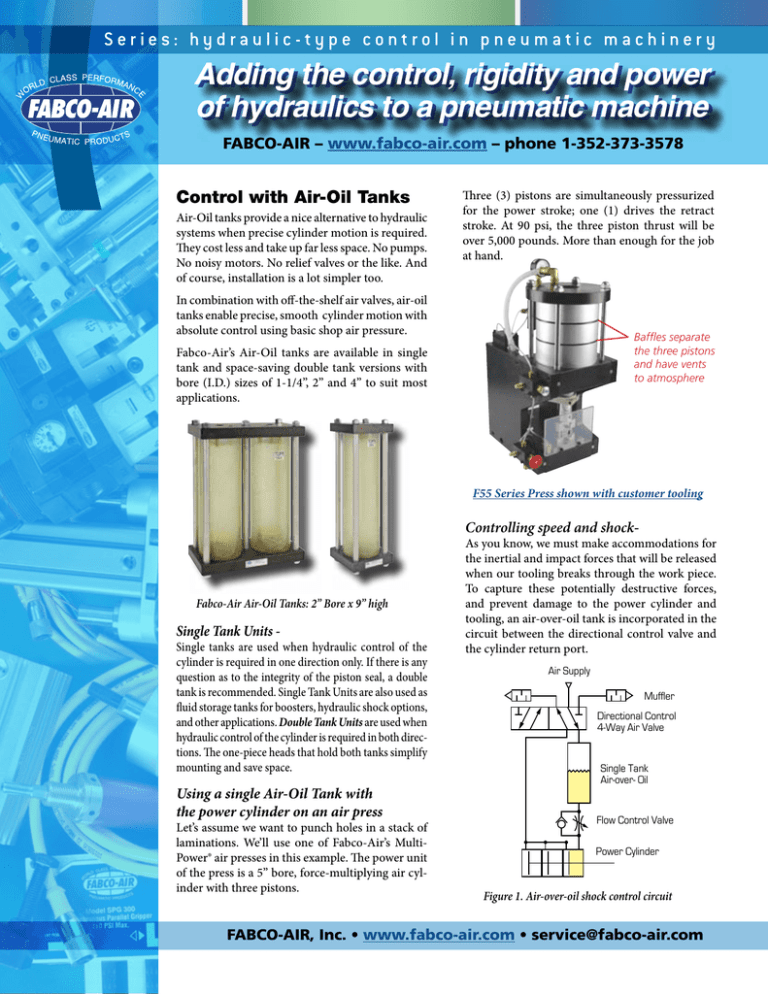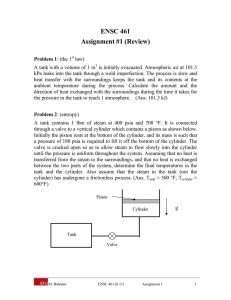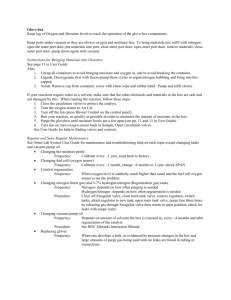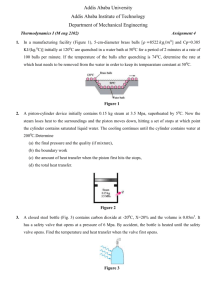Adding the control, rigidity and power of hydraulics to a pneumatic
advertisement

Series: hydraulic-type control in pneumatic machinery Adding Adding the the control, control, rigidity rigidity and and power power of of hydraulics hydraulics to to aa pneumatic pneumatic machine machine FABCO-AIR – www.fabco-air.com – phone 1-352-373-3578 Control with Air-Oil Tanks Air-Oil tanks provide a nice alternative to hydraulic systems when precise cylinder motion is required. They cost less and take up far less space. No pumps. No noisy motors. No relief valves or the like. And of course, installation is a lot simpler too. Three (3) pistons are simultaneously pressurized for the power stroke; one (1) drives the retract stroke. At 90 psi, the three piston thrust will be over 5,000 pounds. More than enough for the job at hand. In combination with off-the-shelf air valves, air-oil tanks enable precise, smooth cylinder motion with absolute control using basic shop air pressure. Baffles separate the three pistons and have vents to atmosphere Fabco-Air’s Air-Oil tanks are available in single tank and space-saving double tank versions with bore (I.D.) sizes of 1-1/4”, 2” and 4” to suit most applications. F55 Series Press shown with customer tooling Controlling speed and shock- Fabco-Air Air-Oil Tanks: 2” Bore x 9” high Single Tank Units - Single tanks are used when hydraulic control of the cylinder is required in one direction only. If there is any question as to the integrity of the piston seal, a double tank is recommended. Single Tank Units are also used as fluid storage tanks for boosters, hydraulic shock options, and other applications. Double Tank Units are used when hydraulic control of the cylinder is required in both directions. The one-piece heads that hold both tanks simplify mounting and save space. Using a single Air-Oil Tank with the power cylinder on an air press Let’s assume we want to punch holes in a stack of laminations. We’ll use one of Fabco-Air’s MultiPower® air presses in this example. The power unit of the press is a 5” bore, force-multiplying air cylinder with three pistons. As you know, we must make accommodations for the inertial and impact forces that will be released when our tooling breaks through the work piece. To capture these potentially destructive forces, and prevent damage to the power cylinder and tooling, an air-over-oil tank is incorporated in the circuit between the directional control valve and the cylinder return port. Air Supply Muffler Directional Control 4-Way Air Valve Single Tank Air-over- Oil Flow Control Valve Power Cylinder Figure 1. Air-over-oil shock control circuit FABCO-AIR, Inc. • www.fabco-air.com • service@fabco-air.com Series: hydraulic-type control in pneumatic machinery FABCO-AIR – www.fabco-air.com – phone 1-352-373-3578 How it works– Tips for using Air-Oil Systems - Fluid in the tank is used for the cylinder’s return media only. (Reference Figure 1, previous page.) Fluid flow and cylinder speed can be controlled by a needle or flow control valve. In our example we have chosen a flow control valve because we want to control the speed of the “work” stroke while allowing a full speed retract stroke. When the material shears and the cylinder tries to complete the stroke, the non-compressible fluid resists rapid movement. It “catches” the built-up forces, dissipating them before the cylinder can bottom out. Thus the piston won’t “pound” on the piston stop. 1 The best control is achieved by installing the speed control valves so that the fluid being forced out of the cylinder is being controlled. Two-Speed work stroke with shock control - Monitoring fluid through the translucent fiberglass With a slight modification to the circuit in Figure 1, using a sequence valve, a needle valve and a shut-off valve, our single air/oil tank provides us with 2-speed work stroke operation shown in Figure 2 below. Muffler 2 The piping between the cylinder and the speed controlling valve should be rigid enough to maintain the required rigidity of the system. 3 It is best to mount the tanks so that the bottoms of the tanks are higher than the cylinder. Cylinder ports should be up with piping running as straight as possible to the tanks. This aids in purging the cylinder of air, by allowing the air to rise through the piping and into the tank where it will dissipate. 1 The highest fluid level should be kept reasonably near the top baffle to avoid excessive air usage, providing the quickest cycle reversal, and to allow for possible fluid loss. 2 If the fluid levels in the tanks become unbalanced, the fluid is bypassing the cylinder’s piston seal. This can occur in a new cylinder with U-Cups designed for air service or side loading on the piston rod. In old systems the bypass can be a result of seal and cylinder wear, seal shrinkage, or other reasons. A crossover valve can allow for tank balancing. (See Figure 4.) 3. Fluid aeration and foaming can reduce intended cylinder control and make its operation “mushy.” Properly designed air-oil tanks have special baffling top and bottom which eliminates such disturbance. (Figure 3.) Fill Port Flow Port Custom molded Buna-N tube seal Translucent fiberglass tube Figure 2. Two-Speed work stroke with shock control The sequence is as follows: 1. Rapid “extend” stroke to approach the work. 2. Automatic switch to controlled rate when resistance is met and pressure builds up to the point where a Fabco-Air RV “Sequence Valve” actuates the 2-way shut-off valve forcing fluidflow through the speed controlling needle valve. (See page 5 for RV info) 3. Fluid catches the cylinder motion, thus controlling the shock that could otherwise occur. 4. Automatic return to rapid rate on the “Cylinder Retract” stroke. Quiet zone below baffle plate for sediment to settle out Baffles force fluid or air to sides of tank, eliminating surface disturbance, aeration & foaming Usable Oil Capacity Brass baffle plates, tube, & spacers, top & bottom Drain Port Flow Port Figure 3. Fabco-Air Single tank construction highlighting the engineered baffle system Page 2 Series: hydraulic-type control in pneumatic machinery FABCO-AIR – www.fabco-air.com – phone 1-352-373-3578 Double Air-Oil Tanks Earlier we discussed controlling cylinder speed in one direction only. When control is required in both directions, two air-oil tanks are needed. As you can see from the circuit shown below, double Air-Oil Tanks used in conjunction with two flow control valves enables hydraulic control with one speed in each direction. Air Supply Muffler Directional Control Valve 4-Way – Air Double Air - Oil Tanks Crossover and shut off provide easy balancing of tank levels Flow Control Cylinder Figure 4.Controlling speed in two (2) directions Bi-Directional, Two-Speed Stop & Hold Here’s another helpful circuit showing double AirOil Tanks used with shut-off valves & needle valves to provide: Now... Add hydraulic power with a pneumatic booster Combining an Air-Oil Tank with a pressure booster provides a convenient, low cost way of adding the control, rigidity, and power of hydraulics to an air powered machine. Fabco-Air Multi-Power® Boosters use basic shop air to raise the pressure of another gas or liquid. They are compact and versatile finding use in numerous applications such as clamping, shearing, pressing, crimping, bending, testing, and many more. Two considerations(1) When relatively small volumes of high-pressure fluid are called for intermittently, boosters show obvious advantages over continuously running hydraulic systems. (2) For applications where high pressure must be maintained for prolonged times, boosters are ideal. After the booster strokes, there is no further energy input required and no heat build up. A booster can be mounted in almost any convenient location, and most of its control valves are installed in the low-pressure circuit where lower cost components save costs over hydraulics. How they work The input is shop air, or any compatible gas, up to 150 psi; the output can be oil, liquid, air, or gas pressurized to 500 psi maximum. Multiple pistons compress the oil or fluid in the output end of the booster. Check valves insure the direction of fluid flow. (1) Stop & hold in either direction at any point in cylinder travel. (2) Choice of rapid or control rate in either direction at any point of cylinder travel. Gravity Feed Oil or Fluid Atmospheric Pressure: Air or Gas Check Valve Not Furnished Piston Center Shaft Air into Single Piston for Reset Stroke Air into Multiple Pistons for Power Stroke. 30 psi Minimum Input Cap End Plug Output End Driving End Nut Tube Seal Pilot Washer Piston Baffle Baffle Seals Seal Check Valve Not Furnished Piston Piston Stop High (Boosted) Pressure Output 500 psi Maximum Figure 6. Function of 2-stage Pressure Booster Figure 5. Bi-directional, 2-speed, stop & hold In Figure 6 above we show only two (2) pistons. But Fabco-Air boosters can have as many as five (5) pistons driving the output. Page 3 Series: hydraulic-type control in pneumatic machinery FABCO-AIR – www.fabco-air.com – phone 1-352-373-3578 Booster becomes a Pump Sizing boosters By selecting the proper combination of bore size, stroke, power factor (determined by number of pistons) and regulating the input air pressure, the exact output pressure and required volume can be achieved and maintained. Adding a magnet piston enables position sensing. Electronic sensors can then control a 4-way solenoid valve causing the booster pistons to reciprocate and pump high pressure liquid. Exhaust liquid is returned to the tank’s top port from the driven device. Available sizes: 2-1/2” and 4”bores Outputs: 4.9 or 12.5 cu. in. per inch of stroke. Strokes 1” to 12”. Fabco-Air BA Series 2-stage Pressure Booster see more info on boosters Atmosphere Regulated Supply Controls Final Output Pressure of Booster Air/Oil Tank Versatility - Since it is a basic booster without controls built-in, it can be adapted and controlled to perform a wide variety of applications. Fabco-Air boosters are not limited to cylinder applications. They may be used wherever a small volume of high-pressure media is required. The BA Series is built for use on systems in which the input to the booster will be gravity fed (no pressure) fluid or atmospheric pressure gas. It requires a 4-way air valve for operation. Porting is provided on the booster for the multiple piston power stroke and single piston reset stroke. Check Valve 4 Way Control Valve Output End Driving End Check Valve Gage Sensors BA Series Booster with Option E Magnetic Piston for Piston Position Sensing Figure 7. BA Booster used as pump with Air-Oil tank reservoir One-shot Holding Cycle Here a single tank air-to-oil booster feeds two (2) clamping cylinders. The clamp-off position of the 4-way pneumatic control releases the clamp cylinders and simultaneously opens the pilot-operated check valve allowing oil to flow back into the tank. Atmosphere Regulated Supply Controls Final Output Pressure of Booster Air/Oil Tank 4 Way Control Valve Pilot Operated Check Valve BA Series Booster Output End Driving End Booster benefits • Low initial cost: Boosters can eliminate the need for costly hydraulic systems. • Low energy cost: Boosters hold pressure indefinitely without energy loss. • Save space: Boosters can usually be mounted directly on the machine unlike pumping units which are large and bulky. • Smooth power: Boosters give a cylinder the rigid, smooth, controlled motion of hydraulics. • Safe: Boosters can be completely air operated to function safely in a potentially hazardous environment. Gage Work Cylinders Figure 7. BA Booster one-shot holding circuit Page 4 Series: hydraulic-type control in pneumatic machinery FABCO-AIR – www.fabco-air.com – phone 1-352-373-3578 Nice to know - Also nice - When you don’t need hydraulic control, but just need to bump up your air pressure, the BP Series air boosters will do the trick with pressure outputs up to 500 psi! The sequence valve used back on page 2, Figure 2, is our RV pressure sensing valve. We find it in use in all sorts of applications, providing pilot signals from adjustable setpoints. Available in 1/8” and 1/4” NPT sizes. Pressurized Input to Booster and to Reset (30 psi Minimum) Check Valve Not Furnished Piston Center Shaft Atmospheric Vent Air into Multiple Pistons for Power Stroke. 30 psi Minimum Input Cap End Plug Output End Driving End Nut Tube Seal Cut-away view of a Fabco-Air RV Sequence Valve Pilot Washer Piston Seals Check Valve Not Furnished Baffle Seal Piston Baffle Read more about it in either of these white papers on our website www.fabco-air.com Piston Stop High (Boosted) Pressure Output 500 psi Maximum Figure 7. BP Series Booster construction This series is built for use on systems in which the input to the booster will be pressurized fluid or gas. It requires a 3-way air valve for operation. Porting is provided on the unit for the power stroke only. When power stroke air is removed, the pressurized booster input will reset the pistons. Maintaining exact forces for best results with a pneumatic press. Controlling cylinder forces with a pressure sensing valve. ❖ about FABCO-AIR since 1958 One of Fabco-Air's 24/7 lights-out machining centers Fabco has all the popular off-the-shelf pneumatic components you want, ready for immediate shipment. Yet almost half of our business comes from helping customers solve design problems with special pneumatic solutions. We can design, prototype and deliver custom samples within 72 hours! Fabco-Air solves problems. Let us help! With operations housed in 61,000 sq. ft. in Gainesville, Florida, Fabco is dedicated to developing and providing advanced fluid power technology to give our customers the competitive edge they need in their field. 24/7 lights-out precision machining centers drive production, assure product quality and enable reliable delivery. Fabco-Air, Inc. • 3716 NE 49th Ave. •Gainesville, FL 32609-1699 Page 5




